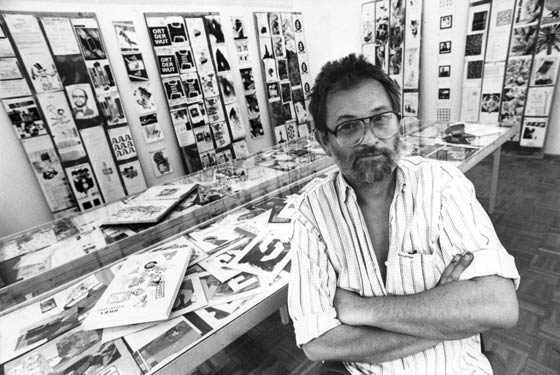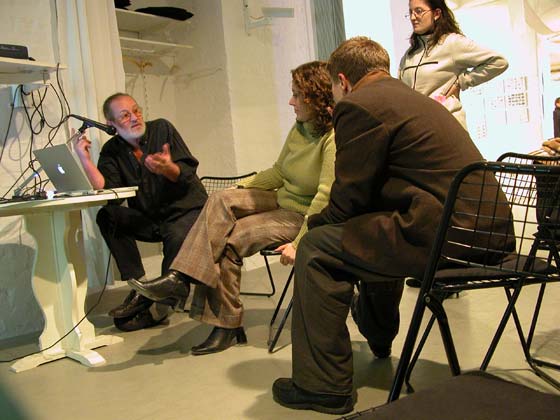The exhibition organised by Artpool Art Research Center in November 2006 and the “art network events” created by the personal meetings related to the exhibition are results of networking, just like Artpool’s “art tour” projects of 1979 and 1982 exhibited in 2004.
The first international Mail Art Congress was organised in 1986 in Switzerland by H.R. Fricker and Günther Ruch. This gave rise to other similar meetings organised mostly in Germany and the USA – where personal meetings were the continuous creative practice by a number of networkers – but also in Hungary. Due to the success of the idea, the next – far more extensive – Decentralised Network Congress in 1992 took place with the involvement of the entire community of networkers worldwide.
Artpool decentralised the congress by fax technology, which was novelty at that time.
Az Artpool Művészetkutató Központ 2006 novemberi kiállítása és az ehhez kapcsolódó személyes találkozások által létrejövő „művészeti network események” – ugyanúgy mint az Artpool 2004-ben már bemutatott 1979-es és 1982-es
hasonlóan szervezett „művészeti utazás” projektjei – a hálózati kommunikáció eredményei.
Az első nemzetközi Mail Art Kongresszust 1986-ban, Svájcban H. R. Fricker és Günther Ruch szervezte. Ennek hatásaként még további találkozók szerveződtek, például még Magyarországon is, de főleg Németországban és az Egyesült Államokban, ahol a személyes találkozásokat több hálóépítő művész (networker) folyamatos alkotói gyakorlattá tette. Az ötlet sikerének tulajdonítható, hogy a következő – jóval nagyobb kiterjedésű – 1992-es Decentralizált Hálózati Viiágkongresszus már az egész korabeli "Networker" világhálót megmozgatta.
Az Artpool az akkor még újdonságnak tekintett fax-technikával decentralizálta a kongresszust.

The issues of communication and art, and the intolerable employee and artisan status of artists were first liberated – irrevocably – by Marcel Duchamp’s paradigmatic ideas. It is no coincidence that virtually every one of his ideas became a new “ism”, and those that did not, such as eroticism and humorism, offer an unexploited and unexplored field of opportunities. Why is that? Because these ideas are conceptual: eroticism and humour, individually or together, can be a part of anything, what’s more, as a kind of spice adding flavour to food, they can be the basis of “communication” with food. Then, it is no wonder that now that “isms” are a thing of the past in art, communication and networking methods have become more appealing and groups organised around “isms” are increasingly being replaced by occasional, rapidly changing, collaborative “network projects”.
The consecutive developments in 20th century visual communication, or correspondence art to be more exact, are especially interesting unexplored precedents of the wide range of communication techniques and uses that have become widespread. The greatest impact was exerted by Fluxus artist Ray Johnson’s New York Correspondence School in the sixties. The European activists of the Fluxus generation, such as Ben Vautier, Robert Filliou, the East European Endre Tót, Milan Knizak, as well as the highly active representatives of concrete, visual and sound poetry worked with the same references and maintained connections in the same way. Referencing, in other words remembering, is always about half-known precedents that need to be processed. Cognition in art raises the possibility of countless versions of interpretations, ranging from reinterpretation to recycling.
A kommunikáció és a művészet kérdéseit, a művész tarthatatlan alkalmazotti szerepét, kézműves voltát elsőként Marcel Duchamp paradigmatikus felismeréseivel szabadította fel, visszavonhatatlanul. Nem véletlen, hogy minden gondolatából egy egy új „izmus” keletkezett. Amiből viszont nem lett „izmus”, mint az erotizmus, vagy a humorizmus, ezekről elmondható, hogy még mindig kiaknázatlan és talán kimeríthetetlen lehetőségeket tartogatnak. Miért? Mert ezek a fogalmak konceptuálisak, az erotika vagy a humor külön-külön vagy együtt bárminek a része lehet, sőt mint valamely ételt ízesítő anyag, az étellel való „kommunikáció” alapja. Ezek után nem csoda, hogy a művészetben az „izmusok” múltával a kommunikáció és ennek hálózati módjai váltak egyre vonzóbbá, és az „izmus” csoportosulásokat egyre inkább felváltják az alkalmi, a gyorsan változó, a kollaboratív „network projektek”.
A 20. századi vizuális kommunikáció, pontosabban a kapcsolatművészet egymást követő fejleményei különösen érdekes feltáratlan előzményei a mára széles körben elterjedt kommunikációs technikák legkülönbözőbb módozatainak és gyakorlatának. A legnagyobb hatású előzmény Ray Johnson fluxus szellemű, koncepciózus New York-i levelező iskolája volt a hatvanas években. A fluxus-generáció európai aktivistái mint Ben Vautier, Robert Filliou, a kelet-európai Tót Endre, Milan Knizak, de a konrét-, vizuális- és hangköltészet nagyon aktív képviselői is ugyanazokkal a hivatkozásokkal dolgoztak és voltak kapcsolatban egymással. A hivatkozás, más szóval az emlékezés mindig a feldolgozandó félig ismert előzményekről szól. A művészi megismerés az újraértelmezéstől az újrafelhasználásig az interpretációk számtalan változatát veti fel.

Who is a good artist? The answer is: the one that can build good relationships. Those that build good relationships can communicate well. From this point on the question “Who is a good artist?” makes no sense because from this point on art is synonymous with communication, no matter what kind or type of “work of art” is discussed. I.e., a “work of art” is information that enables communication. There: we have entered the art of the information society. (György Galántai)
Arra a kérdésre, hogy ki a jó művész, a válasz: aki jó kapcsolatokat épít. Aki jó kapcsolatokat épít, az tud jól kommunikálni. A „ki a jó művész” kérdésnek ettől kezdve nincs értelme, mert művészet ettől kezdve azonos a kommunikációval, bármilyen féle, vagy fajta „mű”-ről legyen is szó. Vagyis a „mű” egy olyan információ, amellyel kommunikálni lehet. Íme: megérkeztünk az információs társadalom művészetébe. (Galántai György)

